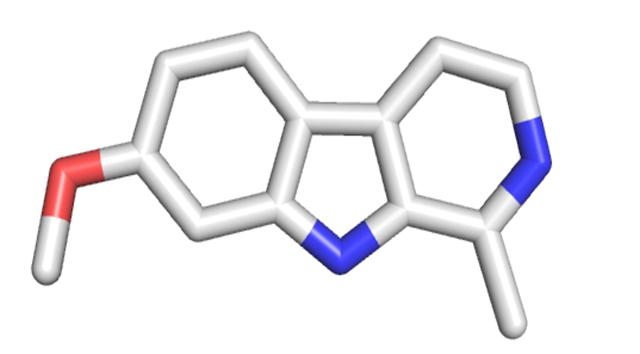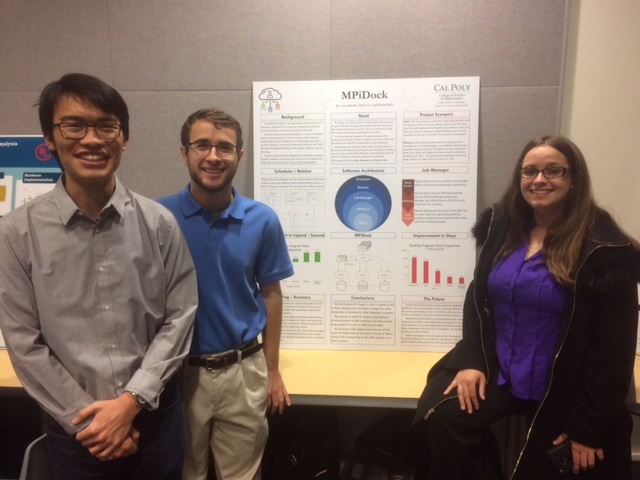Structure Based Virtual Screening
Resources
 Our research lab uses a number of programs to perform in
silico screening assays (the testing of molecules with
a computer program). To do this, we first build a
model of a target protein using either known crystal
structures from NCBI or
using homology
models. We then create a virtual
library of molecules from either publicly available
databases (such as the ZINC
database) or using in-house software such as Spartan. Although
it is possible to test hundreds of millions of compounds, we
typically try to screen less than 10 million compounds in
order to keep the processing time reasonable. We
generally filter the large databases to more reasonable
numbers by selecting for smaller molecules and those with
good ADMET
properties. The programs we usually use to preform
these include Autodock,
Vina, and FRED.
Once the jobs are processed, the programs will indicate
which molecules are suspected to be potent. We then
will synthesize the compounds and test them in a living
system to see if the virtual screen results are
correct. When possible, we try to test several
programs with real biological data prior to beginning a
virtual screen to minimize false hits.
Our research lab uses a number of programs to perform in
silico screening assays (the testing of molecules with
a computer program). To do this, we first build a
model of a target protein using either known crystal
structures from NCBI or
using homology
models. We then create a virtual
library of molecules from either publicly available
databases (such as the ZINC
database) or using in-house software such as Spartan. Although
it is possible to test hundreds of millions of compounds, we
typically try to screen less than 10 million compounds in
order to keep the processing time reasonable. We
generally filter the large databases to more reasonable
numbers by selecting for smaller molecules and those with
good ADMET
properties. The programs we usually use to preform
these include Autodock,
Vina, and FRED.
Once the jobs are processed, the programs will indicate
which molecules are suspected to be potent. We then
will synthesize the compounds and test them in a living
system to see if the virtual screen results are
correct. When possible, we try to test several
programs with real biological data prior to beginning a
virtual screen to minimize false hits.Collaborations
If you are looking for someone to run a structure-based virtual screen, we're always interested in collaborations! We specialize in testing for commercially available compounds that can be purchased and immediately tested in cellular assays, but we are able to run other types of screens as well. A typical docking library is 7-10 million compounds, and our libraries can be tailored for a specific range of properties (molecular weight, polar surface area, log P, etc.). We do not do molecular dynamics or ligand-based screens, sadly.
Ligand Libraries
Our group maintains a collection of several in-house virtual libraries as PDBQT files. Our most commonly used libraries feature a collection of all drug-like, commercially available molecules (updated annually). If you would like a copy of our virtual libraries, please contact us.
Software
We use the following support software most commonly:
- Open Babel
- Autodock Vina
- Smina
- iDock
- ChimeraX
- Cygwin (for a Windows machine)
- Notepad++
- ChemSketch
- ACD NMR Processor
Preparing the Protein Target
Our protocol for preparing the protein target can be found in a PDF document with step-by-step instructions here. Alternatively, you can use the older python script from AutoDock, which you can find info about here.
iDock Virtual Screening
We find iDock to be the fastest free program out there and highly recommend it for a quick job. It's also a well-written program that can get maximum usage out of a system. iDock can be downloaded here. To use run iDock, you'll need to create a directory with the following items in it:
- A PDBQT file of the protein target named foo_DOCK.pdbqt (where "foo" is usually the PDB code)
- The iDock program
- A directory named Ligands that contains all of
the input ligand files in PDBQT format. All input
ligands must have a name beginning with the word
"ligand" like this: ligand02_1554.pdbqt.
These ligands also all need to have a "Name" in the
file. This is most commonly a ZINC ID code, or
something similar. Our script will look for this
to help reference the compounds later.
- A proper configuration file called idock.conf with the ligand folder, protein target, and coordinates set up. In our example, we have placed all ligand files in a directory called "Ligands," and our protein target is called 2vt4_DOCK.pdbqt.
- The configuration file above is set to use 6
cores and with default values. Time per ligand
can vary a lot based on system resources and the size
of input files, but iDock is very fast and most
ligands will be processed in less than a minute.
We have found little improvement by increasing the
default values based on a benchmarking study we did here.
- The screen_idock_v4.2.sh
script for a Linux system or the screen_idock_Win_v4.2.sh
script for Windows.
Once everything is ready, simply execute the script
in the background and let the job run.
| $ nohup ./screen_idock_v4.2.sh & |
Vina is a slightly older program and somewhat slower than iDock, but it's tried and true and available for Linux, PC and Mac. We usually only use Vina if it gives results that most closely match a known set of benchmarks. Vina can be downloaded here.
We have designed our scripts so that you can use the same type of input files and directory structure, so you'll notice that the format is very similar to our iDock procedure above. To run a virtual screen with our Vina script, you'll need to have the following things in the same directory:
- A PDBQT file of the protein target named foo_DOCK.pdbqt
- The Vina program (which is contained in a directory called Vina)
- A directory named Ligands that
contains all of the input ligand files in PDBQT
format. All input ligands must be named with the
word "ligand" in front as with the iDock screen (e.g.
ligand02_1554.pdbqt).
- A properly formatted conf.txt file for Vina to read. You can see an example here where the "#" entries need to be filled in (see the Docking the Classroom page for a full guide).
- Running timing tests are a good idea. Generally, 6-12 CPUs are best depending on your setup. Much larger numbers can actually make the program slower.
- We find the default settings with 10
conformations works well (see our example file above).
- As mentioned before, we don't see much improvement in docking accuracy when we increase the exhaustiveness setting, so we leave it at the default.
- The screen_Vina_v4.2.sh
script for a Linux system, or the screen_Vina_Win_v4.2.sh
script for a Windows machine.
| $ nohup ./screen_Vina_v4.2.sh & |
Note that if you get a "permission
denied" message (which sometimes appears as a bad input
message on a PC or a cowardly statement claiming it can't
find the conf.txt), just use the chmod command and try
again:
| $ chmod -R 775 ./ $ nohup ./screen_Vina_v4.2.sh & |
Once the script begins running, it
will grab the "Name" entry from each ligand file as before
and place the compiled names in the IDs.txt file in a new
directory called Results (same as iDock). It will then
go through and check all input PDBQT files for problem lines
that can cause Vina to fail. This may take a few
minutes. The script will then dock each ligand in the
Ligands file. Once done, it will again extract the
best energies, rank them, and match them by "Name" in the
IDs.txt file. The final output file will be called
Summary_Final.txt. Output PDBQT files can be converted
to PDB files using Open Babel.
You can find a detailed procedure on how to run a virtual screen with our scripts by looking at the tutorials found on our Docking in the Classroom page.
Smina Virtual Screening
Smina is a fork of Vina that can be found here. If you have no benchmarks to test different programs, we have found that Smina works the best based on a benchmarking study with the DUD-E database (link). Sadly, Smina is only available for Linux systems. If you want to run a Smina screen, then you can use our screen_Smina_v4.2.sh script. Your input directory should be configured exactly the same way as with Vina (with identical configuration file format), with the only difference being that you need to have the smina.static program instead of the Vina program.
AutoDock Virtual Screening
We no longer use AutoDock, as it's very slow and cannot thread. Recent papers seem to make convincing cases that it gives inferior performance to boot. Not a bad program, but better things are out there.
Virtual Screening in the Classroom
If you are a professor and are interested in teaching virtual screening, it can be done! See our Docking in the Classroom page for a full tutorial.
Ligand Based Screening Resources
We normally only target proteins with known structures, so we have little experience with ligand based screening techniques. However, a number of open-source programs, including installation and usage instructions, can be found on the Insilab website here. Thanks to Praveen Kumar M for the suggested link.
You can find a detailed procedure on how to run a virtual screen with our scripts by looking at the tutorials found on our Docking in the Classroom page.
Smina Virtual Screening
Smina is a fork of Vina that can be found here. If you have no benchmarks to test different programs, we have found that Smina works the best based on a benchmarking study with the DUD-E database (link). Sadly, Smina is only available for Linux systems. If you want to run a Smina screen, then you can use our screen_Smina_v4.2.sh script. Your input directory should be configured exactly the same way as with Vina (with identical configuration file format), with the only difference being that you need to have the smina.static program instead of the Vina program.
AutoDock Virtual Screening
We no longer use AutoDock, as it's very slow and cannot thread. Recent papers seem to make convincing cases that it gives inferior performance to boot. Not a bad program, but better things are out there.
Virtual Screening in the Classroom
If you are a professor and are interested in teaching virtual screening, it can be done! See our Docking in the Classroom page for a full tutorial.
Ligand Based Screening Resources
We normally only target proteins with known structures, so we have little experience with ligand based screening techniques. However, a number of open-source programs, including installation and usage instructions, can be found on the Insilab website here. Thanks to Praveen Kumar M for the suggested link.
MPiDock
The MPiDock program is a program designed to run on networked terminals with iDock and Vina. At the outermost level, it consists of a scheduler, written as a command line interface for crontab, which then calls the batcher, which is a program that divides up input files and executes commands remotely with those input files, allowing parallelization across all terminals. The program is freely available on GitHub here. MPiDock was developed at Cal Poly by Dennis Li, Derek Nola and Lucy Bowen (pictured below, left to right)

The MPiDock program is a program designed to run on networked terminals with iDock and Vina. At the outermost level, it consists of a scheduler, written as a command line interface for crontab, which then calls the batcher, which is a program that divides up input files and executes commands remotely with those input files, allowing parallelization across all terminals. The program is freely available on GitHub here. MPiDock was developed at Cal Poly by Dennis Li, Derek Nola and Lucy Bowen (pictured below, left to right)